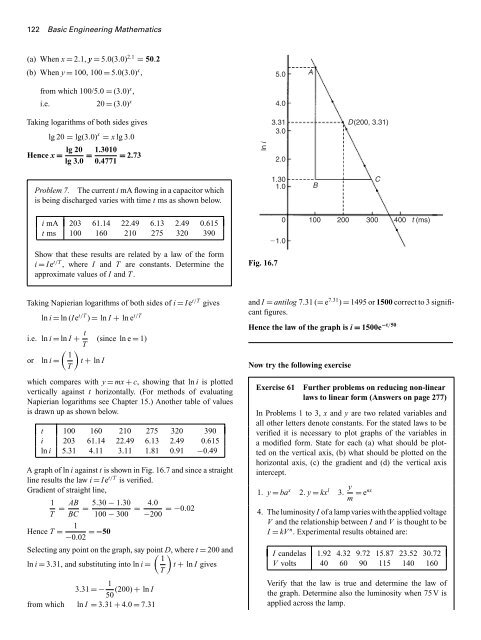basic_engineering_mathematics0
You also want an ePaper? Increase the reach of your titles
YUMPU automatically turns print PDFs into web optimized ePapers that Google loves.
122 Basic Engineering Mathematics<br />
(a) When x = 2.1, y = 5.0(3.0) 2.1 = 50.2<br />
(b) When y = 100, 100 = 5.0(3.0) x ,<br />
from which 100/5.0 = (3.0) x ,<br />
i.e.<br />
20 = (3.0) x<br />
Taking logarithms of both sides gives<br />
Hence x =<br />
lg 20 = lg(3.0) x = x lg 3.0<br />
lg 20<br />
lg 3.0 = 1.3010<br />
0.4771 = 2.73<br />
ln i<br />
5.0 A<br />
4.0<br />
3.31<br />
3.0<br />
2.0<br />
D(200, 3.31)<br />
Problem 7. The current i mA flowing in a capacitor which<br />
is being discharged varies with time t ms as shown below.<br />
1.30<br />
1.0<br />
B<br />
C<br />
i mA 203 61.14 22.49 6.13 2.49 0.615<br />
t ms 100 160 210 275 320 390<br />
Show that these results are related by a law of the form<br />
i = Ie t/T , where I and T are constants. Determine the<br />
approximate values of I and T.<br />
0<br />
1.0<br />
Fig. 16.7<br />
100 200 300 400 t (ms)<br />
Taking Napierian logarithms of both sides of i = Ie t/T gives<br />
ln i = ln (Ie t/T ) = ln I + ln e t/T<br />
i.e. ln i = ln I + t (since ln e = 1)<br />
T<br />
( ) 1<br />
or ln i = t + ln I<br />
T<br />
which compares with y = mx + c, showing that ln i is plotted<br />
vertically against t horizontally. (For methods of evaluating<br />
Napierian logarithms see Chapter 15.) Another table of values<br />
is drawn up as shown below.<br />
t 100 160 210 275 320 390<br />
i 203 61.14 22.49 6.13 2.49 0.615<br />
ln i 5.31 4.11 3.11 1.81 0.91 −0.49<br />
A graph of ln i against t is shown in Fig. 16.7 and since a straight<br />
line results the law i = Ie t/T is verified.<br />
Gradient of straight line,<br />
1<br />
T = AB 5.30 − 1.30<br />
=<br />
BC 100 − 300 = 4.0<br />
−200 =−0.02<br />
Hence T = 1<br />
−0.02 = −50<br />
Selecting any point on the graph, say point ( D, ) where t = 200 and<br />
1<br />
ln i = 3.31, and substituting into ln i = t + ln I gives<br />
T<br />
3.31 =− 1 (200) + ln I<br />
50<br />
from which ln I = 3.31 + 4.0 = 7.31<br />
and I = antilog 7.31 (= e 7.31 ) = 1495 or 1500 correct to 3 significant<br />
figures.<br />
Hence the law of the graph is i = 1500e −t/50<br />
Now try the following exercise<br />
Exercise 61<br />
Further problems on reducing non-linear<br />
laws to linear form (Answers on page 277)<br />
In Problems 1 to 3, x and y are two related variables and<br />
all other letters denote constants. For the stated laws to be<br />
verified it is necessary to plot graphs of the variables in<br />
a modified form. State for each (a) what should be plotted<br />
on the vertical axis, (b) what should be plotted on the<br />
horizontal axis, (c) the gradient and (d) the vertical axis<br />
intercept.<br />
1. y = ba x 2. y = kx l y<br />
3.<br />
m = enx<br />
4. The luminosity I of a lamp varies with the applied voltage<br />
V and the relationship between I and V is thought to be<br />
I = kV n . Experimental results obtained are:<br />
I candelas 1.92 4.32 9.72 15.87 23.52 30.72<br />
V volts 40 60 90 115 140 160<br />
Verify that the law is true and determine the law of<br />
the graph. Determine also the luminosity when 75V is<br />
applied across the lamp.















![[Lonely Planet] Sri Lanka](https://img.yumpu.com/59845622/1/169x260/lonely-planet-sri-lanka.jpg?quality=85)

